18 Mouth-Watering Valencian Dishes | Eat Like a Local
Not only does Valencia have its very own language, but the third largest city in Spain also has a phenomenal culinary scene that few outsiders know about.
Valencia is well-known for being the birthplace of traditional paella, but Valencian food is SO MUCH more than paella and has tonnes to offer in terms of flavour, quality ingredients and variety.
It was with this in mind that I decided to put together this handy guide to Valencian food to ensure you don’t miss anything if you visit this incredible city.
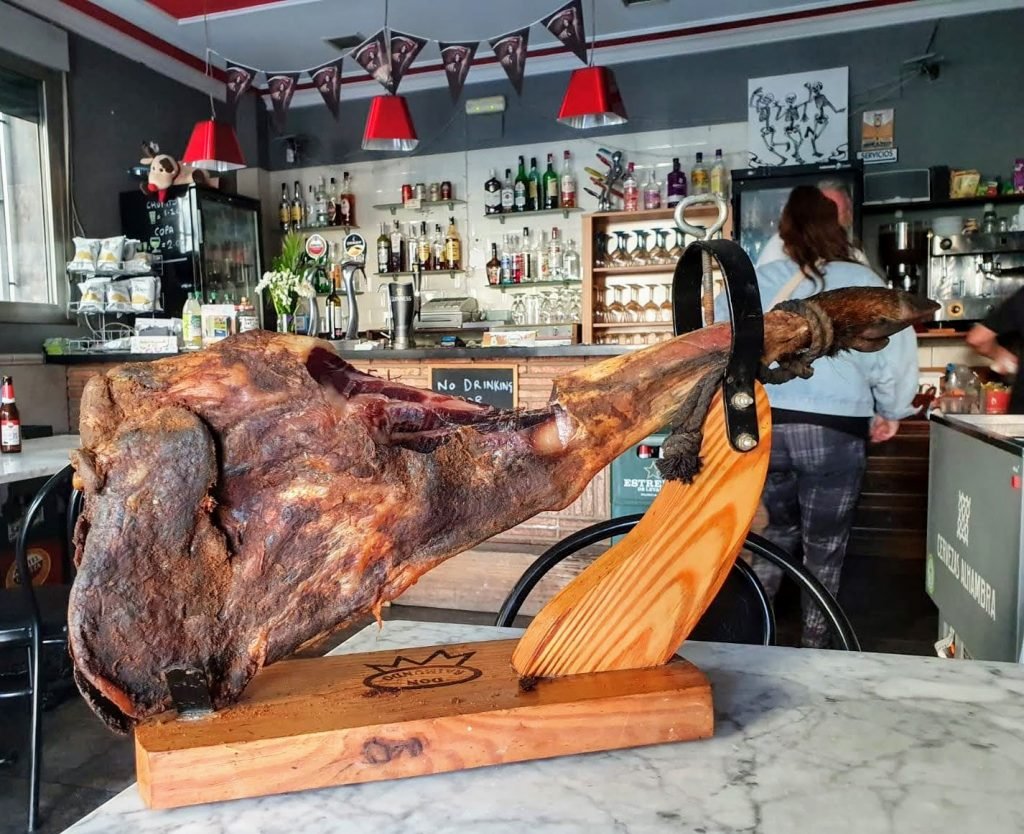
I’ve been living in the province of Valencia for over a year now (first in a little pueblo named Oliva before moving to the city of Valencia in June 2021), and Spanish food continues to amaze me.
So, grab a glass of Sangria and get comfortable, because it’s going to be a long one.
Here are the best Valencian dishes that you simply have to try if you visit the city of Valencia Spain.
Valencian Food Guide | Traditional Valencian Foods You Have to Try
Valencian Food in a Nutshell
Although Valencian food is incredibly diverse, the one ingredient that holds everything together is rice (there’s even a rice museum in Valencia!).
From dry rice dishes to ‘brothy rice,’ oven-baked and everything in between, Valencians are proud of their rice dishes, and whether they’re served with meat or seafood, you can’t go wrong when you order rice in Valencia.
In fact, Valencians are so proud of their rice that Valencian rice even has its own Denomination of Origin!
Fresh seafood is very popular along the coast and in the city centre, while the more mountainous areas such as Montanejos are best known for their hearty comfort food – think rich stews, game meat, beans and smoked sausage.
Valencia also has numerous wine regions, with the Utiel-Requena area having its own Denomination of Origin and license to produce Cava.
18 Traditional Valencian Dishes
1. Paella Valenciana (Valencian Paella)
I couldn’t write a Valencian food guide and not put Valencian paella right at the very top.
So many people associate paella with Spanish food generally, but Valencia is actually home of the paella (specifically the village of El Palmar, near Lake Albufera).
While you’d be forgiven for thinking that traditional paella involves seafood, paella Valenciana is actually made with chicken, rabbit, snails, green beans and garrafó (butter beans) and flavoured with saffron and rosemary.
The rice is dry and should stick to the bottom of the pan in a crispy layer (the pan is actually called a ‘paella’), and while it is typically eaten at lunchtime, some tourist menus will serve paella Valenciana for dinner as well.
If you’re visiting Valencia and want to try paella from its actual birthplace, this tour to El Palmar includes paella, seafood tapas and a boat trip on Lake Albufera.

2. Fideuà
Fideuà is basically paella but with hollow noodles called fideuà instead of rice.
Fideuà are very fine noodles, similar to angel hair pasta, which are cut into small pieces.
Unlike paella Valenciana, fideuà is typically served with seafood such as shrimp, cuttlefish, squid, crayfish and monkfish, cooked in fish stock and seasoned with fresh lemon.
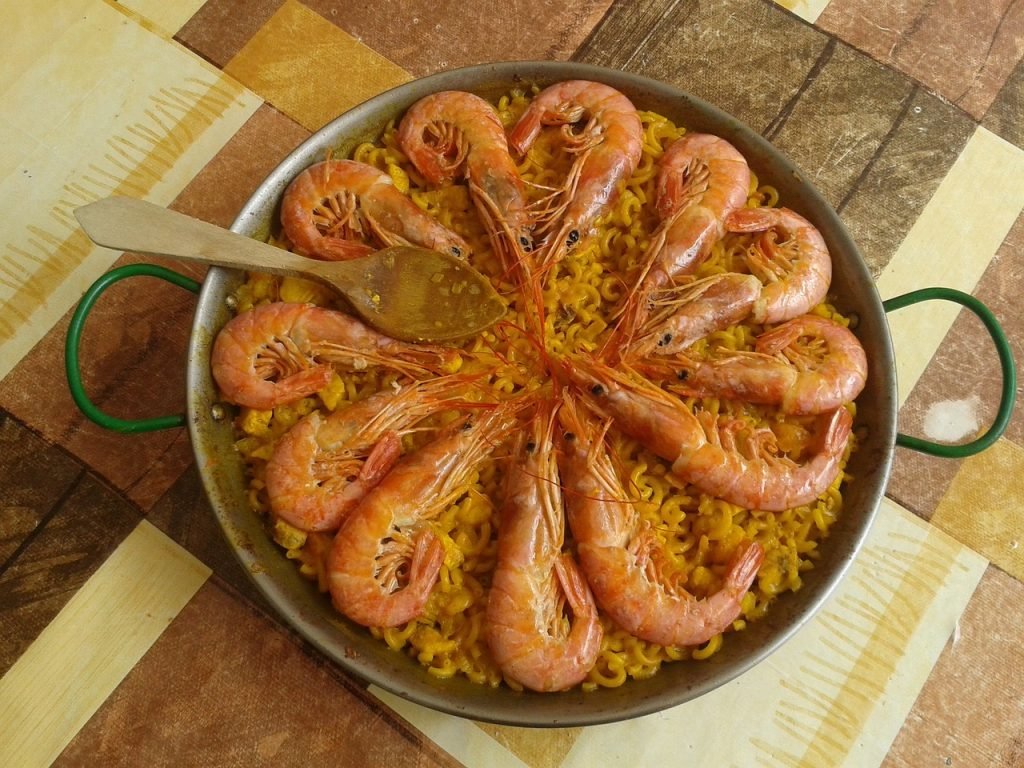
3. Alcachofas (Artichokes)
Of course, artichokes are not unique to Valencia, but the town of Benicarló is famous for its artichokes, which have their own Designation of Origin!
In fact, Benicarló is SO proud of its artichokes that it has an annual artichoke festival every January, where local restaurants go to town in creating their best dishes using artichokes, from desserts to sauces, tapas dishes to main courses.
They even invite local artists to create artwork surrounding the not-so humble artichoke, and claim that ‘It wouldn’t be January without enjoying the delights of the Benicarló artichoke.’
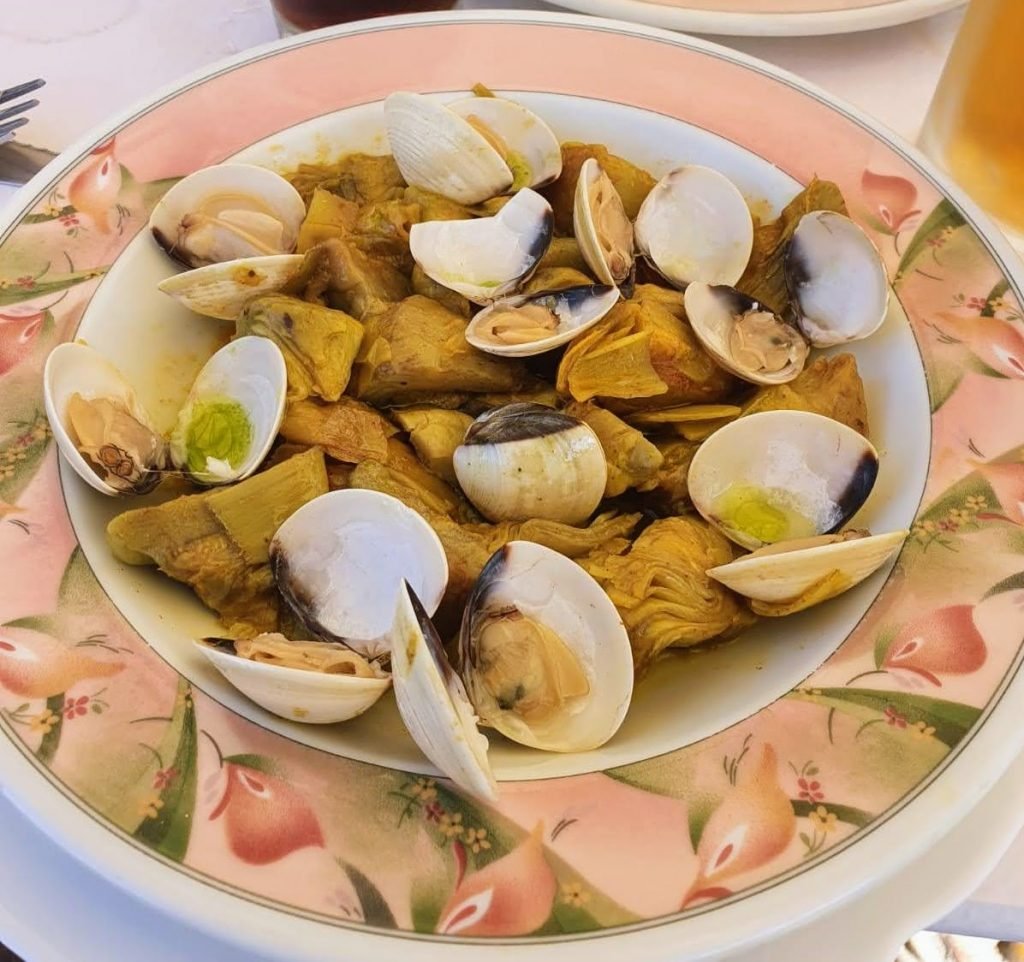
4. Esgarraet
You will see esgarraet on many menus in Valencia.
This local dish is made with strips of salted bacalao (cod fish), roasted red bell peppers, garlic and olive oil (and sometimes black olives). Its name means ‘tearing’ in Valencian, and refers to the tearing of bell peppers and bacalao.
Esgarraet is served at room temperature as a tapa.
5. Mojama
Mojama is considered a delicacy and is produced not only in Valencia, but also in the provinces of Huelva and Cadiz, as well as Murcia and Almeria.
Mojama is raw Bluefin tuna, sliced and salted, marinated in different spices and soaked in extra virgin olive oil.
It is a popular dish at Bodega Casa Montaña, one of Valencia’s oldest and best tapas restaurants.
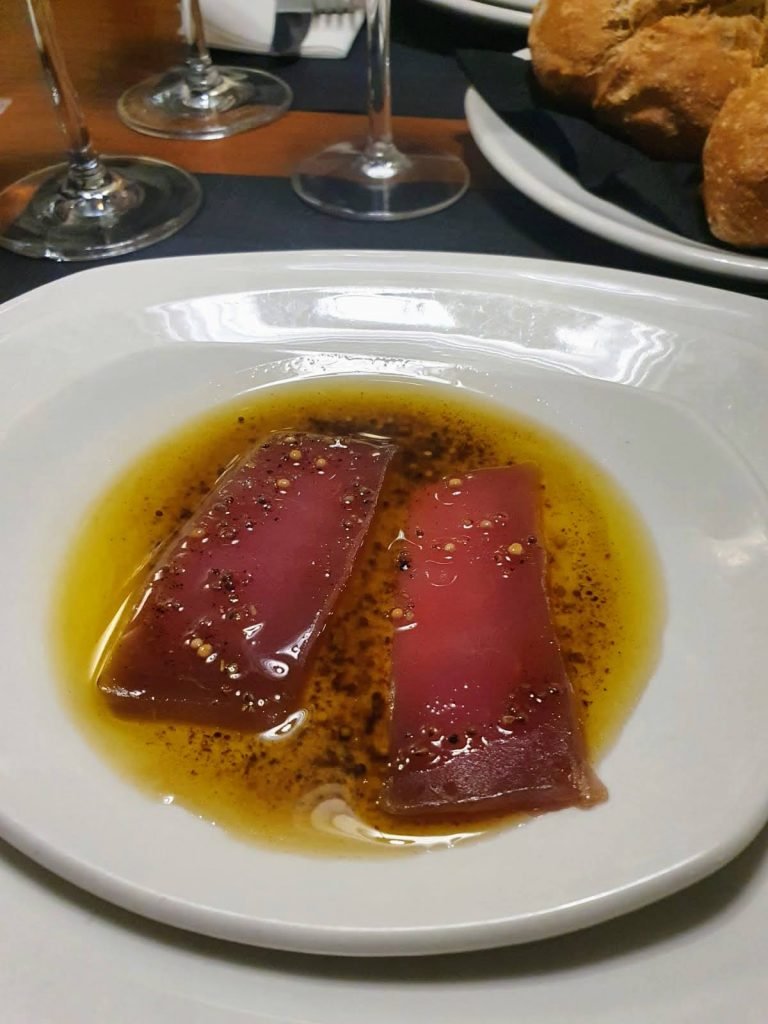
6. Stewed Broad Beans – Michirones
Michirones are traditionally from Murcia, but this dish is popular all across Southeast Spain, including Valencia.
Broad beans, or fava beans, are a typical Spanish food, and in Valencia they are stewed in gravy for a period of time to allow them to soak it up and become creamy on the inside.
This gravy is made with chorizo, bacon, paprika, black pudding and garlic, giving it a rich flavour that is perfect for winter.
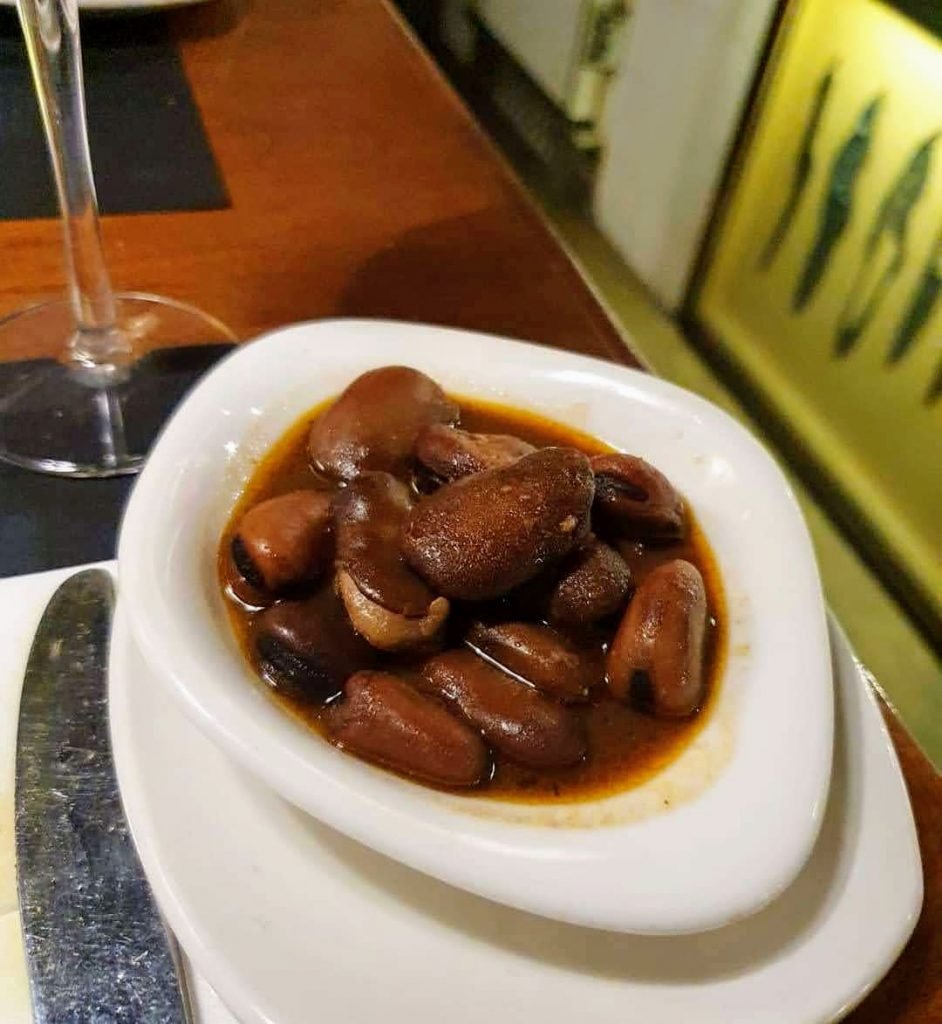
7. Agua de Valencia
While not technically a Valencian food, Agua de Valencia is a Valencian drink made from the famous Valencia oranges, which DO count as a Valencian food, and it is such a staple of Valencian culture that it definitely deserves its place on the list.
With freshly squeezed orange juice and cava taking centre stage in this cocktail, you would be forgiven for thinking it sounds just like a Mimosa, but actually, an Agua de Valencia is far more dangerous (and delicious!) due to the additional presence of vodka and gin.
Pretty much every single bar in Valencia sells pitchers of Agua de Valencia, and it is beloved by locals and tourists alike.
It’s actually super easy to make at home, so if you’re curious, go ahead and check out my Agua de Valencia recipe!
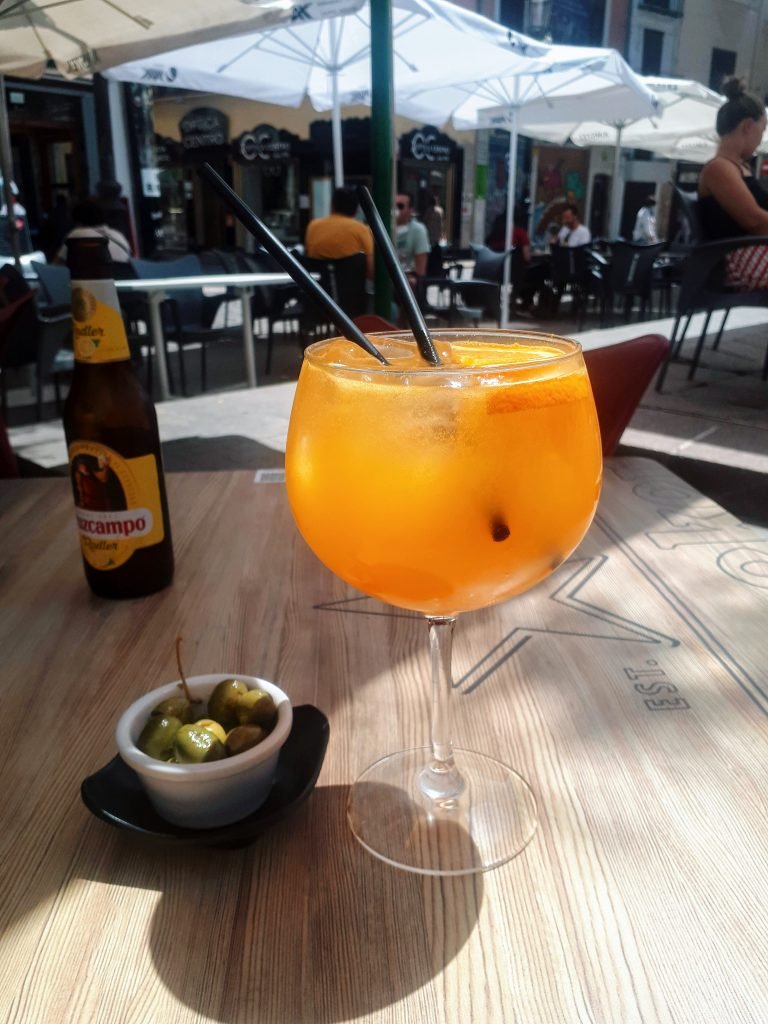
8. Arroz a Banda
Arroz a banda (or arròs a banda in Valencian) is another Valencian rice dish which originated in Alicante (a province in the Communidad de Valencia).
This dish, whose name translates to ‘rice served apart,’ is served in parts (funny that).
First comes a fish stew with a local fish, potatoes, ñora pepper and garlic.
It is accompanied by rice cooked in a fishy broth, which was traditionally made from leftover fish that Alicante’s fishermen couldn’t sell.
A dollop of alioli on top is the finishing touch.
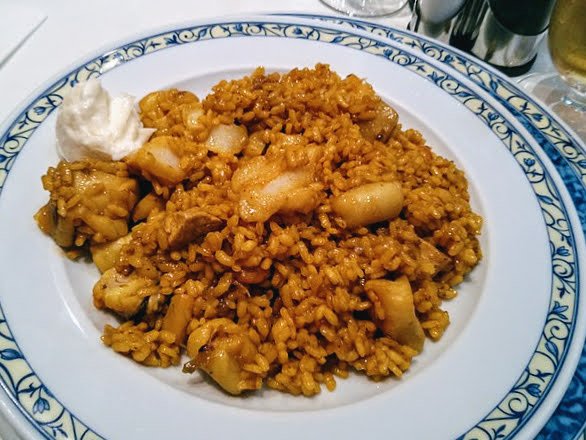
9. Arroz al Horno (Rice in the Oven)
Arroz al Horno, or arròs al forn in Valencian, is another rice dish (I told you there’d be plenty!), this time very dry and crispy on the bottom.
This dish is what gives ‘comfort food’ its name. It’s homemade, it’s hearty and it’s the kind of food that warms the soul.
Made with rib meat, chorizo and morcilla (blood sausage), as well as chick peas, potatoes and lots of garlic, this is a meaty dish that is guaranteed to fill your belly.
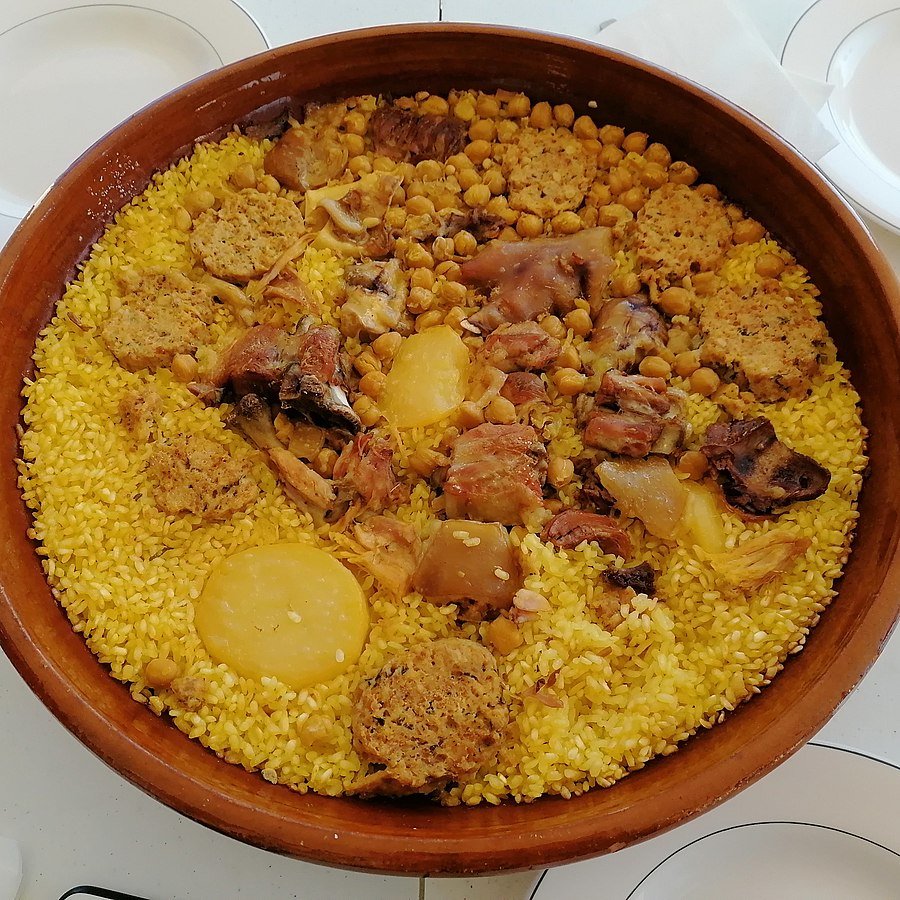
10. Buñuelos de Calabaza
Buñuelos are very similar to doughnuts and are traditionally eaten during the Fallas festival in Valencia.
These fried pastries are made with sweet pumpkin batter and sprinkled with liberal amounts of sugar, and are the ultimate guilty pleasure.
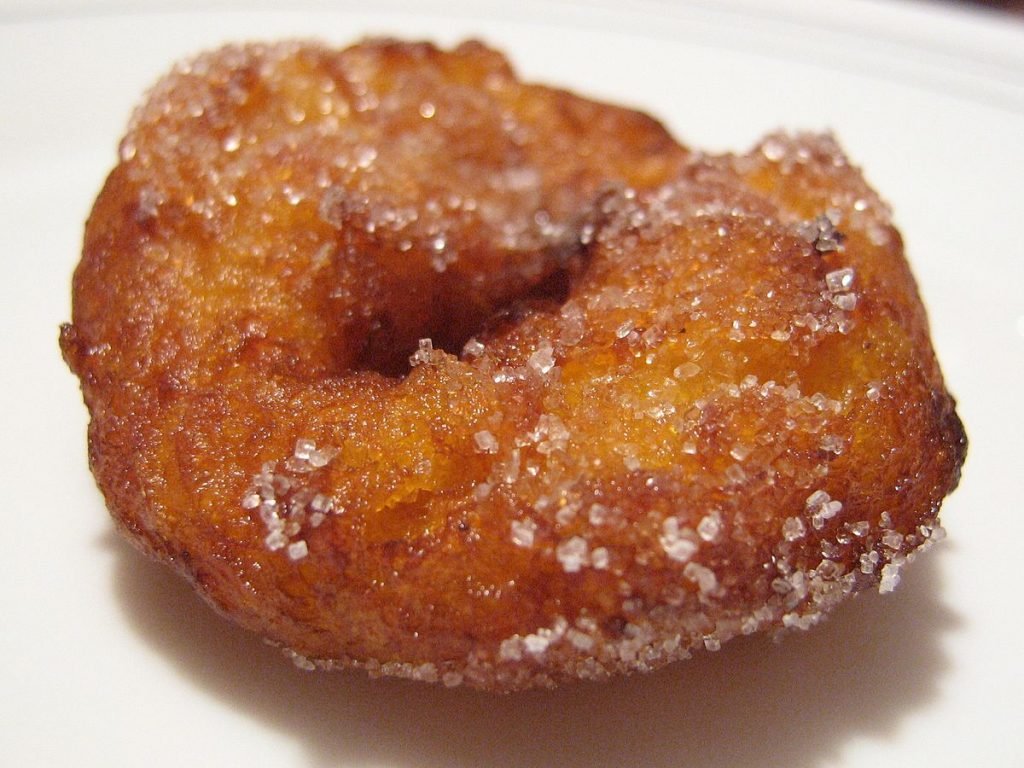
11. Arroz Negro
Arroz Negro, or Arròs Negre in Valencian, is a Valencian and Catalan dish that gets its jet black colouring from cuttlefish or squid ink.
Seasoned with liberal amounts of garlic, paprika and fish stock (as well as the obligatory squirt of fresh lemon), this flavourful dish also contains seafood such as shrimp and squid.

12. Jamón Ibérico
Jamón Ibérico can of course be found throughout Spain, but no trip to Valencia is complete without indulging in some.
The best that money can buy is the Black Label, 100% Acorn-fed Iberian ham, which is the rarest, most expensive and highest-quality of Iberian ham there is.
Produced from free-range, 100% pure-bred, acorn-fed Iberian pigs, the shoulders are hung and dried for at least 24 months and are the finest of all Spanish ham types.
With a high amount of fat, a delicate taste and a melt-in-your-mouth texture, Black Label Iberian Ham is certainly special.
You can try Black Label Iberian Ham at Casa Montana.

13. Bollit
Bollit is a very simple stew which is served as a side dish and is comprised of gherkins, carrots, pickled onion, potato and green beans and soaked in oil and vinegar.
14. Horchata y Fartons
Yes, I smirked when I first heard the name ‘fartons’ too!
Horchata (or Orxata in Valencian) translates to ‘tiger nut milk,’ and refers to a sweet drink made from tiger nuts, which are edible tubers and part of the potato family.
Valencia actually grows 90% of the world’s tiger nuts, which are ground with water and sugar to produce horchata.
For the truth Valencian experience, order some fartons to dip into your horchata.
Fartons are local pastries dusted with icing sugar and are the perfect accompaniment to horchata.
A beautiful place to try Valencian horchata is Horchateria Santa Catalina in Valencia Old Town, a touristy but stunning spot.
You can also head to Port Saplaya for some of the best horchata around.

15. Sobrasada
Although sobrasada is originally from the Balearic islands (it was everywhere in Mallorca!), it is also extremely popular in Valencia.
Sobrasada is a kind of spread made from mincing together various parts of the pig.
It has a high fat content and soft texture similar to pâté, and is seasoned simply with salt and paprika, making it a real guilty pleasure.
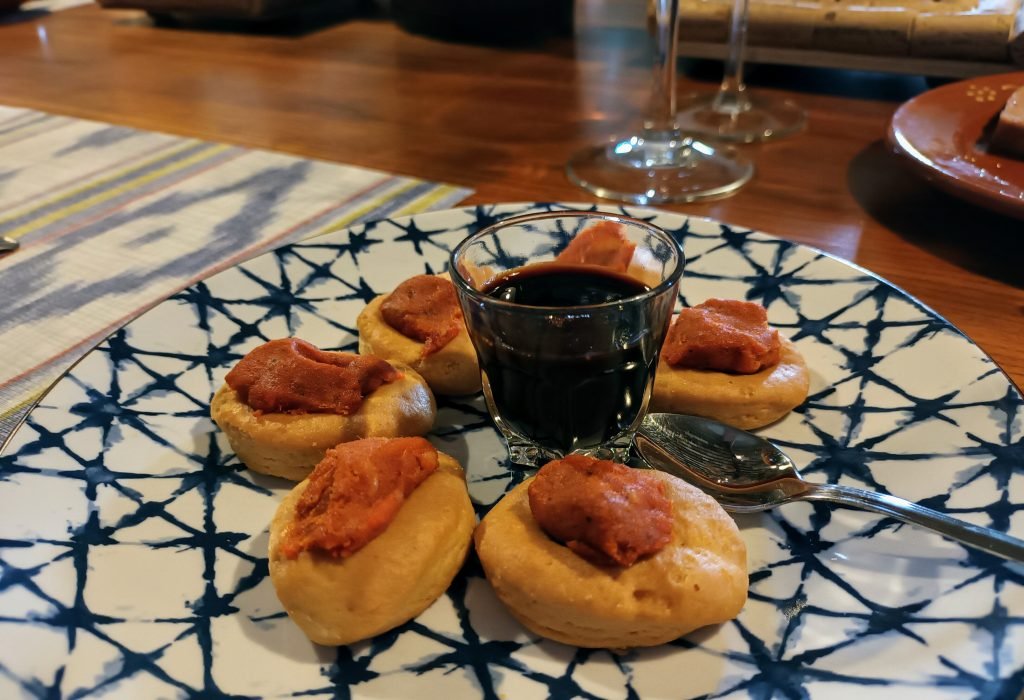
16. Blanco y Negro Bocadillo
The blanco y negro bocadillo is a traditional almuerzo food.
Almuerzo is the ‘second breakfast’ meant to tide hungry Spaniards over until lunchtime, and usually takes the form of a bocadillo, which is a type of sandwich served on a baguette.
Blanco y negro refers to the ingredients – longaniza (white sausage) and morcilla (black sausage).
Morcilla is the Spanish answer to the British black pudding (fun fact – my hometown of Bury is famous for its black pudding!) and is a type of blood sausage, while longaniza is a sausage made from minced meat and similar to chorizo.
Other ingredients such as scrambled egg, pickled onion, fried tomatoes and alioli can also be added.
17. Flan de Calabaza
Flan is a super popular dessert in Spain, and Valencians love everything pumpkin-flavoured, so it almost goes without saying that pumpkin flan is one of the most common desserts here.
While British flan is kind of like a sponge cake, the Spanish flan is more like a crème caramel, with a wobbly, custard-like texture that just melts in the mouth.
Flan is on pretty much every dessert menu in Valencia, so you’ll have a hard time NOT trying it!

18. Turrón
Turrón is the Spanish answer to nougat and it originates from the small village of Jijona.
Although it is traditionally a Christmas dessert, you will find it in Valencia all year round in pretty much every flavour imaginable, from marzipan to kiwi fruit.
Turrón is made by cooking honey, sugar, egg white and peeled and toasted almonds.
Valencian Food Guide | Final Thoughts
So, that just about brings us to the end of my Valencian food guide!
I hope that I have expelled some myths that Spanish food is limited to paella and patatas bravas.
From grilled seafood to belly-warming rice dishes, sweet treats and everything in between, Valencian foods cater to all tastes, and if you travel to Valencia to sample some local cuisine, you will not be disappointed.
Did I miss anything? Let me know in the comments section below!
Until next time
XOXO
If you liked this article and would like to support my work, please click the button above to donate a couple of bucks and buy me a coffee. The ad revenue that I receive on this website is minimal, so support from my readers enables me to keep creating content that you (hopefully!) love to read.
Disclaimer: This page contains affiliate links. If you make a purchase on a recommended site, I may earn a commission at no extra cost to you.

3 Comments